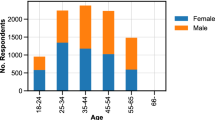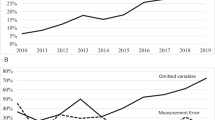Abstract
Using data from government agencies, a survey of 200 “Fortune 500” type companies, and data derived by the IRU, the average number of hours worked annually 1947–1979 was examined and found to have declined significantly. Because the workweek has remained stable and does not reflect the dramatic rise in paid time off since 1947, the workyear is now a more valid standard of measurement. To compensate for lost production hours, many firms have taken steps to raise the productivity of hours worked, including increased overtime and shift work, the introduction of automation and other technological advances, and flexible manufacturing systems.
Similar content being viewed by others
References
For a discussion of biases found in estimating annual hours, refer to Anthony M. J. Yezer, “Evaluating Methods for Estimating Annual Hours of Work,”American Statistical Association 1977 Proceedings of the Business and Economic Statistics Section, Part I (Washington, D.C.: American Statistical Association, 1977), pp. 664–667.
See Herbert R. Northrup and Howard G. Foster,Open Shop Construction, Major Study No. 54 (Philadelphia: Industrial Research Unit, The Wharton School, University of Pennsylvania, 1975), esp. pp. 317–319.
Percentage differences in overtime hours are derived from United States Department of Labor, Bureau of Labor Statistics,Handbook of Labor Statistics, Bulletin 2070 (Washington, D.C.: U.S. Government Printing Office, 1980), p. 178.
Ibid..
Ibid..
United States Department of Labor, Bureau of Labor Statistics,Handbook of Labor Statistics, Bulletin 2070 (Washington, D.C.: U.S. Government Printing Office, 1980), p. 412. These are the official degree of unionization figures. That they may be overstated is clear. See Gordon F. Bloom and Herbert R. Northrup,Economics of Labor Relations, Ninth Edition (Homewood, Ill.: Richard D. Irwin, Inc., 1981), pp. 68–76.
For a discussion of the tradeoff between hiring additional workers and overtime hours, see Robert Clark,Adjusting Hours to Increase Jobs: An Analysis of the Options, National Commission for Manpower Policy Special Report No. 15 (Washington, D.C.: U.S. Government Printing Office, 1977).
Murray F. Foss,Changes in the Workweek of Fixed Capital: U.S. Manufacturing, 1929 to 1976 (Washington, D.C.: American Enterprise Institute Studies in Economic Policy, 1981), p. 2.
, p. 2–3.
Bloom and Northrup,Economics of Labor Relations, p. 570.
Ibid.
“A Full Time Job — Weekends Only,”Business Week, October 15, 1979, pp. 150–152.
Herbert R. Northrup, James T. Wilson, and Karen M. Rose, “The Twelve-hour Shift in the Petroleum and Chemical Industries,”Industrial and Labor Relations Review, Vol. 32, (April 1979), pp. 312–326.
Bloom and Northrup,Economics of Labor Relations, pp. 570–571.
See, e.g., Paul R. Haas et al,Understanding Manufacturing Systems (Milwaukee: Kearney & Trecker Corporation, n. d. [1979]).
See, e.g., Steve Lohr, “New in Japan: The Manless Factory,”New York Times, December 13, 1981, sec. 3, pp. 1, 27f.
Employment and Earnings, Vol. 26, No. 1 (January 1979), p. 219.
Janice Neipert Hedges and Daniel E. Taylor, “Recent Trends in Worktime: Hours Edge Downward,Monthly Labor Review, Vol. 103 (March 1980), p. 7.
Author information
Authors and Affiliations
Additional information
This study is part of a larger endeavor undertaken by the Industrial Research Unit. The research has been supported by special gifts from several companies and foundations, and by the Labor Relations Council of The Wharton School. The authors would like to thank Cheryl DellaPenna and Patricia Dornbusch of the IRU for editorial assistance.
Rights and permissions
About this article
Cite this article
Northrup, H.R., Greis, T.D. The decline in average annual hours worked in the United States, 1947–1979. Journal of Labor Research 4, 95–113 (1983). https://doi.org/10.1007/BF02685169
Issue Date:
DOI: https://doi.org/10.1007/BF02685169




